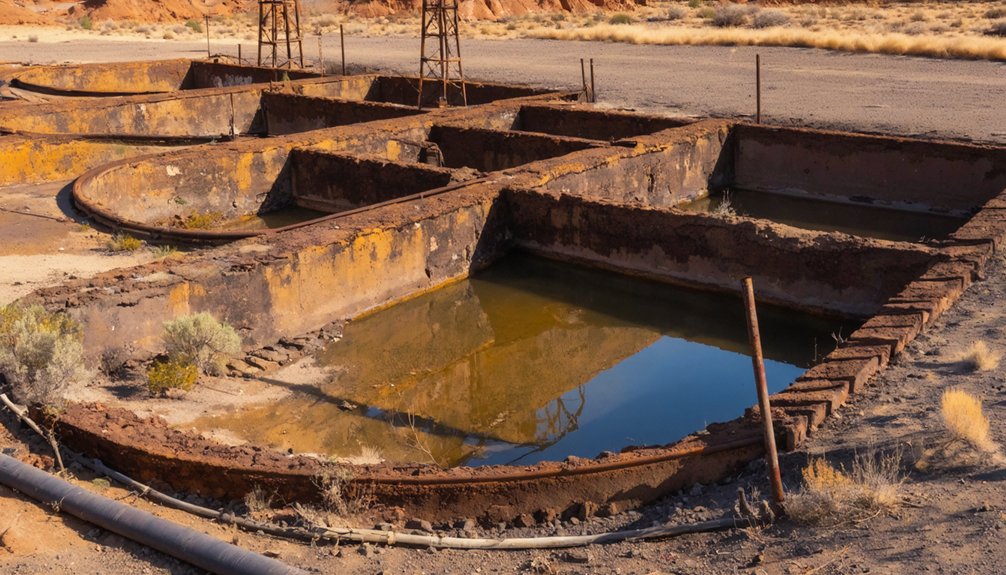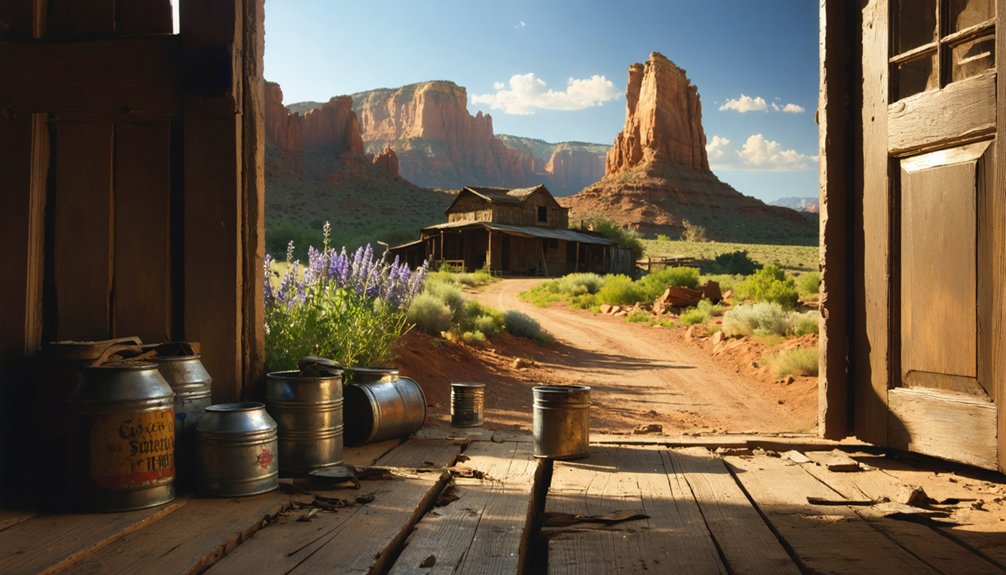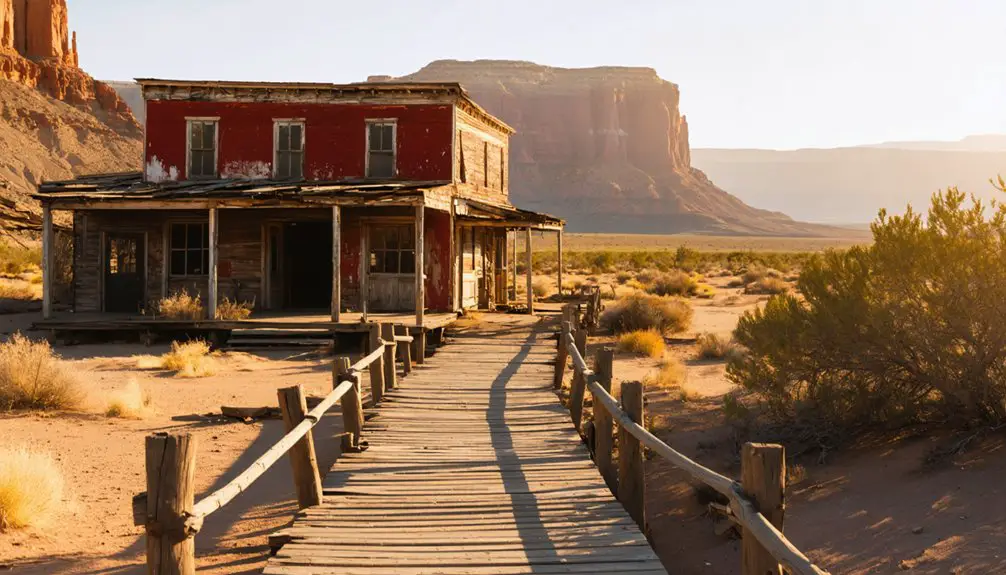You’ll discover Rainbow’s haunting ruins in Utah’s remote Uinta Basin, where this former “Queen of mining camps” thrived during the early 1900s gilsonite boom. The company town housed 30 mining families in regulated conditions, complete with mountain spring water and strict social policies. While operations shifted to Bonanza in 1938, you can still explore Rainbow’s scattered foundations, roofless structures, and historic water system at coordinates 39.8418, 109.1829 – each crumbling remnant tells a deeper story.
Key Takeaways
- Rainbow was a company-controlled gilsonite mining town in Utah that flourished during the early 1900s before its abandonment in 1938.
- The town housed approximately 30 mining families in company-built homes with access to piped mountain spring water.
- Mining operations centered around gilsonite extraction, with workers using basic tools to load 200-pound burlap bags by hand.
- The town’s social life revolved around a one-room schoolhouse, with strict company policies including alcohol prohibition.
- Today, visitors can explore scattered ruins, building foundations, and the old railroad terminus at coordinates 39.8418, 109.1829.
The Rise of a Mining Frontier
While the discovery of gilsonite in 1868 occurred by chance when a blacksmith’s request for coal led Native Americans to bring back an unexpected mineral, this mishap launched Rainbow’s mining frontier.
You’ll find that early settlers quickly staked their claims, even before fully grasping gilsonite’s potential uses. British investors helped finance many of these early mining operations, continuing their pattern of heavy Utah mining investment from 1871-1873.
Samuel Gilson and Bert Seaboldt emerged as pioneering figures, experimenting with the mineral and securing crucial financing for its development.
Although initial efforts at commercialization faced challenges, an examination revealed gilsonite contained over 95% hydrocarbons.
Life in a Company-Controlled Town
As gilsonite mining operations expanded, Rainbow emerged as a tightly controlled company town housing approximately 30 mining families.
You’d find yourself living in a company-built frame or log house along a well-maintained main street, with pure mountain spring water piped directly to your home. The company’s influence touched every aspect of daily life – from the strict “no alcohol” policy to regulated social activities. After Dragon’s decline, Rainbow became the new center for Gilsonite mining. The town flourished as the Queen of mining camps during its peak years.
Your children would attend the one-room schoolhouse with about ten other students, marked by its distinctive belfry.
While the company provided essential infrastructure and services, you’d experience significant social control over your lifestyle and behavior. This system of oversight reflected the mining company’s drive to maintain order and maximize productivity in this remote Utah outpost.
Mining Operations and Economic Impact
Once the railroad terminus relocated from Dragon to Rainbow in 1911, this remote Utah outpost became a bustling center of gilsonite mining for nearly three decades.
You’d find miners using basic tools – picks and shovels – to extract the valuable black ore from narrow vertical veins, reaching depths of about 100 feet. Mining technology remained simple but effective: workers loaded 200-pound burlap bags by hand and hoisted them from the shafts. The area’s rich deposits also yielded significant amounts of lead and silver.
While Rainbow’s gilsonite was slightly lower grade than Dragon’s, reduced mining costs made operations profitable. The narrow-gauge Uintah Railway provided essential market access, replacing expensive wagon transport. The company enforced a strict no alcohol policy in town.
The town supported 30 families until 1938, when operations shifted to Bonanza. Though Rainbow’s economy also included nearby lead and silver mining, gilsonite extraction remained the lifeblood of this company town.
Daily Living and Community Spirit
You’d find Rainbow’s social life centered around its one-room schoolhouse, where about ten students learned from a single teacher while the building doubled as a community gathering place.
Similar to ladies’ clubs that organized dances and teas in Inez, residents found ways to maintain an active social calendar despite isolation. The mining company’s strict oversight extended into nearly every aspect of daily life, including a firm prohibition on alcohol and tight control over housing arrangements. Residents enjoyed access to pure mountain water from a large tank system that served the town.
Despite these restrictions, the close-knit community of roughly thirty families maintained their spirit through shared experiences and mutual support, living and working together in their isolated canyon setting.
School and Social Life
While many mining towns struggled to maintain social cohesion, Rainbow’s tight-knit community of 30 families centered their daily lives around a one-room schoolhouse and company-provided amenities. Typical of mining ghost towns, the settlement eventually declined when the nearby mines closed.
You’d find about ten students attending classes under the watchful eye of their teacher, described as “pretty” by historical accounts. The schoolhouse’s belfry bell marked the rhythm of daily school activities and community events. The residents enjoyed access to pure mountain water from a large storage tank that supplied the entire town.
Standing at one end of the main street, this modest building served as more than just a place of learning – it was a symbol of community pride and stability.
Though the mining company enforced strict rules, including a no-alcohol policy, families found ways to build connections through informal gatherings and shared experiences in their small, isolated town.
Company Rules and Structure
As a prime example of early 20th-century corporate oversight, Rainbow’s company policies shaped every aspect of daily life for its 30 mining families. Under strict regulations, you’d find yourself living in a company-built home, drinking company-supplied mountain spring water, and following their notorious no-alcohol policy without question.
The company governance extended far beyond basic rules, controlling everything from housing arrangements to community resources. You’d see homes painted uniformly and spaced evenly along the street, reflecting the company’s desire for order and efficiency.
While these restrictions might seem oppressive, they created a unique community spirit. You’d experience a close-knit environment where families shared resources, gathered for social events, and maintained traditions despite the controlling atmosphere.
The Water System Legacy

Despite its remote location in Uintah County, Rainbow’s sophisticated water system served as a demonstration of early 20th-century engineering ingenuity.
You’ll find evidence of remarkable infrastructure innovation in the elevated water tank that once supplied the entire town through gravity-fed distribution. The system’s design brought pure mountain spring water from Baxter Pass to approximately 30 families, demonstrating early water conservation techniques in Utah’s semi-arid climate.
When you explore Rainbow today, you can still locate the remnants of this essential system, including the water tank’s foundation near the railroad terminus.
The engineering solutions were particularly creative – from using mirrors to illuminate deep well repairs to developing advanced pipe casing systems for wells exceeding 400 feet in depth. These adaptations guaranteed the town’s survival despite its challenging environment.
From Boom to Abandonment
Once Rainbow established itself as the “Queen of Gilsonite mining camps” in 1911, the town’s fortunes remained closely tied to the precious black mineral’s extraction.
Despite advancements in mining technology and the discovery of oil in 1920, Rainbow’s destiny changed dramatically in 1938 when operations relocated to Bonanza, 15 miles north.
You’d find it fascinating how quickly a thriving community of 30 families could vanish.
Unlike other ghost town legends that tell of gradual decline, Rainbow’s end came swiftly and decisively. The company dismantled many buildings, relocating them to Bonanza, while leaving others to crumble into ruins.
Exploring the Ruins Today

Today’s visitors to Rainbow encounter a haunting tableau of scattered ruins against Utah’s mountainous desert landscape.
Your ghost town exploration reveals building foundations, roofless structures, and dugouts that tell the story of this once-bustling mining community.
Crumbling walls and empty doorways stand as silent witnesses to Rainbow’s forgotten past, when miners once called these ruins home.
While no intact buildings remain, you’ll find fascinating remnants of the town’s infrastructure, including the water system and railroad terminus.
For successful historical preservation and safe exploration, remember:
- Navigate using GPS coordinates (39.8418, 109.1829), as formal trails and signage are limited
- Pack essential supplies, considering the remote location and extreme temperatures
- Document but don’t disturb the fragile ruins and artifacts, including distinctive purple glass bottles
Watch your footing among the unstable structures and uneven terrain while exploring this remote site, where cell service is unreliable but the scenic views are unmatched.
Frequently Asked Questions
Were There Any Notable Accidents or Deaths in Rainbow’s Mining Operations?
You’ll find no recorded major mining accidents unique to Rainbow’s operations, though the area’s historical incidents reflect broader mining safety concerns throughout central Utah’s coal mining region.
What Happened to the Mining Equipment and Infrastructure After Abandonment?
You’ll find most mining equipment was dismantled or removed when operations ceased in 1938. Infrastructure decay took its toll – leaving only foundations, rubble, and abandoned shafts as silent witnesses to Rainbow’s past.
Did Any Original Rainbow Residents Settle Permanently in Nearby Bonanza?
Like shadows fading into desert dust, you can’t definitively track Rainbow residents’ moves to Bonanza, though it’s likely some miners and their families followed the work when operations shifted north in 1938.
Were There Any Churches or Religious Services in Rainbow?
You won’t find records of formal churches in Rainbow, though religious practices and community gatherings may have occurred informally. The company town’s schoolhouse wasn’t documented as hosting religious services.
What Was the Average Wage for Miners Working in Rainbow?
You’d have earned between $3-4 per day as a Rainbow miner, comparable to other Utah mining camps. Your average salaries depended on your role, with surface workers making less than skilled miners.
References
- http://www.expeditionutah.com/forum/index.php?threads/ghost-town-rainbow-ut.5318/
- http://poorlygradedgravel.blogspot.com/2010/06/ghost-town-tuesday-watson-dragon-and.html
- https://neonbison.com/rainbow-mountains-of-utah/
- https://www.youtube.com/watch?v=s3zoXQZbKY4
- https://jacobbarlow.com/2020/04/13/rainbow-utah/
- https://gilsoniteco.com/2017/04/09/gilsonite-history/
- https://historytogo.utah.gov/mining/
- https://utahrails.net/mining/brewster.php
- https://westernmininghistory.com/mine-detail/10021252/
- https://geology.utah.gov/map-pub/survey-notes/gilsonite-an-unusual-utah-resource/



